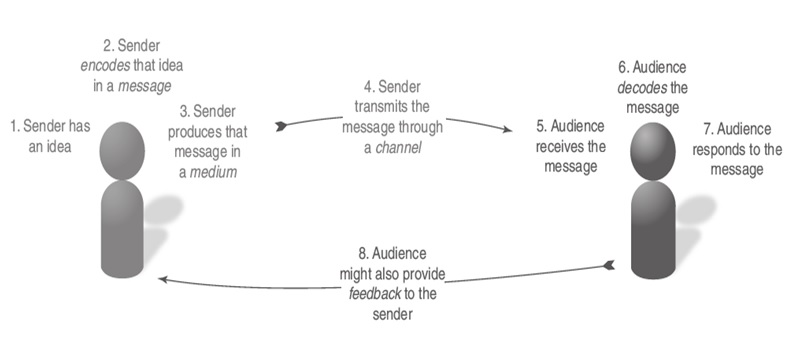
Communication can be viewed as a process, and you can identify and improve the skills you need to be more successful.
Here we take a look at the basic communication model.
GET INSTANT HELP FROM EXPERTS!
- Looking for any kind of help on your academic work (essay, assignment, project)?
- Want us to review, proofread or tidy up your work?
- Want a helping hand so that you can focus on the more important tasks?
Hire us as project guide/assistant. Contact us for more information
Several variations on this process model exist, but these eight steps provide a practical overview:
- The sender has an idea. Whether a communication effort will ultimately be effective starts right here and depends on the nature of the idea and the motivation for sending it. For example, if your motivation is to offer a solution to a problem, you have a better chance of crafting a meaningful message than if your motivation is merely
to complain about a problem. - The sender encodes the idea as a message. When someone puts an idea into a
message—which you can think of as the “container” for an idea—he or she is
encoding it, or expressing it in words or images. Much of the focus of this course
is on developing the skills needed to successfully encode your ideas into effective
messages. - The sender produces the message in a transmittable medium. With the appropriate
message to express an idea, the sender now needs a communication medium
to present that message to the intended audience. To update your boss on the
status of a project, for instance, you might have a dozen or more media choices,
from a phone call to an instant message to a slideshow presentation. - The sender transmits the message through a channel. Just as technology continues to increase the number of media options at your disposal, it continues to provide new communication channels you can use to transmit your messages. The distinction between medium and channel can get a bit murky, but think of the medium as the form a message takes (such as a Twitter update) and the channel as the system used to deliver the message (such as a mobile phone).
- The audience receives the message. If the channel functions properly, the message reaches its intended audience. However, mere arrival at the destination is no guarantee that the message will be noticed or understood correctly. As “How Audiences Receive Messages” explains, many messages are either ignored or misinterpreted
as noise. - The audience decodes the message. After a message is received, the receiver needs to extract the idea from the message, a step known as decoding. “How Audiences Decode Messages” takes a closer look at this complex and subtle step in the process.
- The audience responds to the message. By crafting messages in ways that show the benefits of responding, senders can increase the chances that recipients will respond in positive ways. However, as “How Audiences Respond to Messages” points out, whether a receiver responds as the sender hopes depends on the receiver (1) remembering the message long enough to act on it, (2) being able to act on it, and (3) being motivated to respond.
- The audience provides feedback to the sender. In addition to responding (or not responding) to the message, audience members may give feedback that helps the sender evaluate the effectiveness of the communication effort. Feedback can be verbal (using written or spoken words), nonverbal (using gestures, facial expressions, or other signals), or both. Just like the original message, however, this feedback from the receiver also needs to be decoded carefully. A smile, for example, can have many meanings.
Considering the complexity of this process—and the barriers and distractions that often stand between sender and receiver—it should come as no surprise that communication efforts often fail to achieve the sender’s objective. Fortunately, the better you understand the process, the more successful you’ll be.
The following sections take a closer look at two important aspects of the process: environmental barriers that can block or distort messages and the steps audiences take to receive, decode, and respond to messages.
StudyMumbai.com is an educational resource for students, parents, and teachers, with special focus on Mumbai. Our staff includes educators with several years of experience. Our mission is to simplify learning and to provide free education. Read more about us.

Leave a Reply
You must be logged in to post a comment.